
To view and download the official document: http://www.fs.fed.us/ne/newtown_square/publications/information_bulletins/pdfs/ne_inf16-73p.pdf
[Note from the web master. The word heal may be used here to describe the closure of a wound. Dr. Shigo now calls it closure and not healing. That and other terms, such as vigor verses vitality, can be found at www.treedictionary.com for your use. John A. Keslick , Jr.]

This booklet outlines what happens most of the time as decay develops in a living tree. The drawings are designed to give an accurate general presentation of the decay process by focusing only on the major portions of an extremely complex process that involves the interactions among microorganisms, environmental factors, and the tree. The better we understand these processes the better we can prevent and control decay-the major cause of damage to all species of trees throughout the world.
The information and illustrations are based on the Pioneer Forestry Research Project of Dr. Alex L. Shigo, a Forest Service Plant Pathologist, stationed at the Forestry Sciences Laboratory in Durham, New Hampshire. This booklet was originally issued by the Northeastern Forest Experiment Station, Forest Service, U.S. Department of Agriculture, in 1973 under the same title.
This publication is part of a USDA Forest Service program designed to provide information on the wise use and care of trees-some of our most versatile and renewable natural resources. Other booklets in this series include Your Tree's Trouble May Be You, AIB-327; Rx For Wounded Trees, AIB-387; Compartmentalization of Decay in Trees, AIB-405; and Tree Decay-An Expanded Concept, AIB-419.
The illustration on the cover illustrates how the fruit body of a fungus on a large old basal wound indicates internal decay as shown by the cut-away section.
Art work is by DAVID M. CARROLL, Illustrator
TREE HURTS, TO0
A tree, like a human person, can be hurt.
. . Hurt in the sense of injury, damage, or wounds, but of course not in the sense of feeling pain. And like a human person, a tree has ways of healing its wounds and curing-or at least living with-the wound diseases that afflict it.Page 1
TREES are well adapted for life on earth. In some ways, they are superior organisms. Trees live longer and grow taller and larger in mass than any other living thing on the land and in the sea.
Compare the size and longevity of
MAN
to
Largest land animal-Elephant-12 feet tall
Largest sea animal-Blue whale-100 feet long; 150 tons
Tallest sea plant-Giant kelp-300 feet long
Oldest tree-Bristlecone pine-5,000 to 6,000 years old.
Tallest and largest trees
Redwood and Sequoia-over 325 feet tall; 2,000 to 3,000 years old. (All drawings are to scale.)
Page 2

Click here for larger picture.
Page 3
But, despite their fine adaption to life on this planet, they too- like all organisms-

Page 4

Page 5

Page 6

Page 7
TREES die from many causes-diseases, pollution, fire, environmental extremes, insects, animals, etc.

Left - Sick Pine Right - Sick Birch
Page 8
Yet a major cause of DEFECT, DEATH, and DECAY of all species of trees throughout the world is infection of WOUNDS by microorganisms.

Page 9
Some microorganisms are beneficial; some are destructive. Their life-span
is measured in days, and their size in thousandths of an inch. But without them, no organic matter would decompose, there would be no reuse of once-living materials, and thus there would be no continuation of life.
[Note from web master: The Micron bar may not be an accurate size as you see it on your monitor]
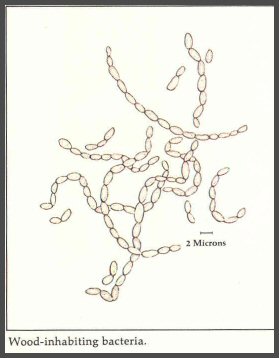
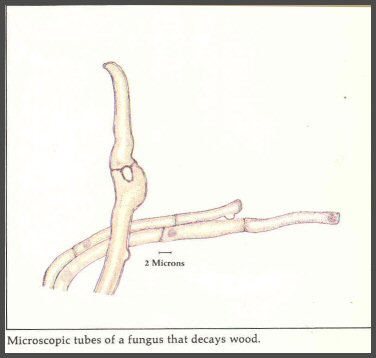
Page 10

Page 11
Trees live longer and grow taller and larger than other organisms mainly because they have very effective ways of resisting death and decay. Over millions of years, trees have developed effective built-in systems of protection against wounds and infection by microorganisms.

Page 12
Microorganisms that cause decay sometimes surmount the protective barrier set up by the tree after wounding. When the tree's vigor is high and the wounds are minor, the advantage tips toward the tree. When the tree's vigor is low and the wounds are severe, the advantage tips toward the invading microorganisms. The cumulative effects of many minor stress factors over time also tip the balance in favor of the microorganisms.
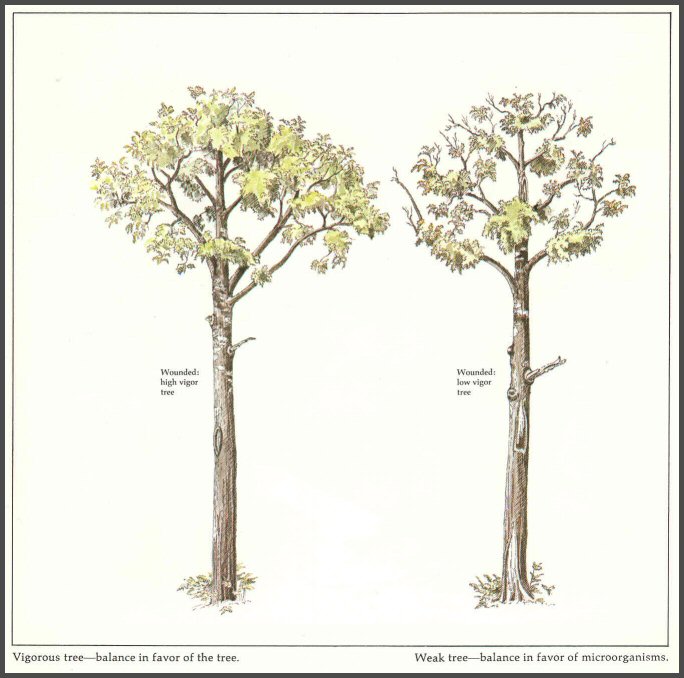
Click here for larger picture.
Page 13
A TREE should be thought of as a multiple plant, rather than as a single one, for the cambium-the layer of tissue one cell thick between the wood and the bark-produces a completely new layer of wood and bark tissue every growing season. In a sense, a new tree envelops the old one every year.
- - - - - - - - - - - - - - - - - - - - - - - - - - - - - -
- - - - - - - - - - - - -
Anatomy of a red oak.

The appearance of the tree with bark when it was
A-8 years old.
B-10 years old.
C-12 years old.
D-22 years old.

yellow-sapwood; wood containing living cells.
brown-heartwood; wood altered by natural aging processes; no living cells.
green-cambium; living cells that produce new tissues.
[Note from webmaster - The cambium zone of trees is - most of the time -
not green. I mention this because of much misunderstanding regarding the
cambium zone - JAK - You can look up cambium zone at
www.treedictionary.com ]
Page 14

1-vessels. 2-ray cells-living cells in sapwood.
3-pith-center of tree.
4-inner bark or phloem; materials flow downward mostly.
5-wood or xylem; in sapwood materials flow upward mostly.
6-outer bark-protective shield.
Page 15
The chemical barriers formed in the wood around the wound inhibit invasion by most microorganisms, but certain ones sometimes can grow through the barrier. When this happens, a second wave of different microorganisms moves in behind the first invaders.. Still others follow. A SUCCESSION of microorganisms is involved in the processes that result in decay.
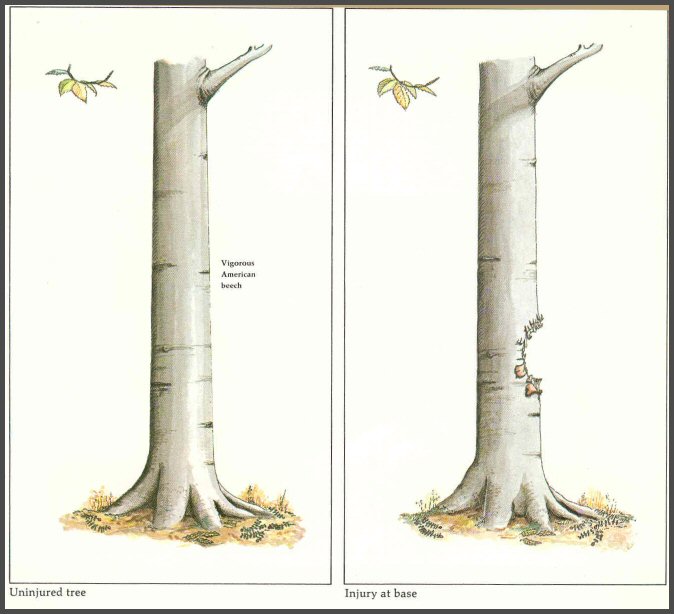
Page 16
Color key to all drawings
RED-Host response to wounding, chemical reactions- to STOP invasion,
GREEN-Invasion processes by microorganisms-to GO through the barriers set up by the tree.
BLUE-Infection of dead and dying tissues on wound surface.
BROWN-Decay processes.
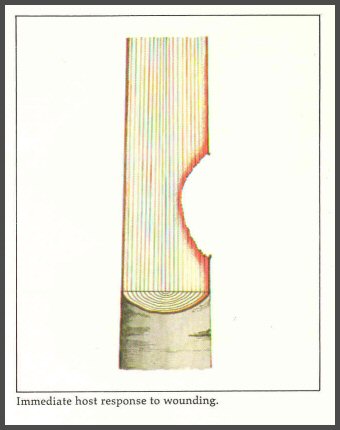

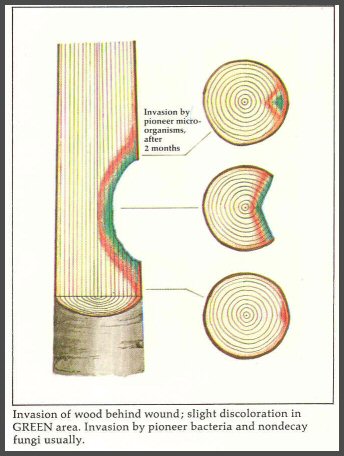
Page 17

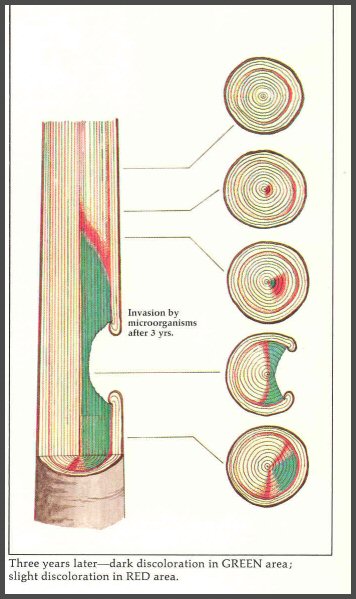
Page 18
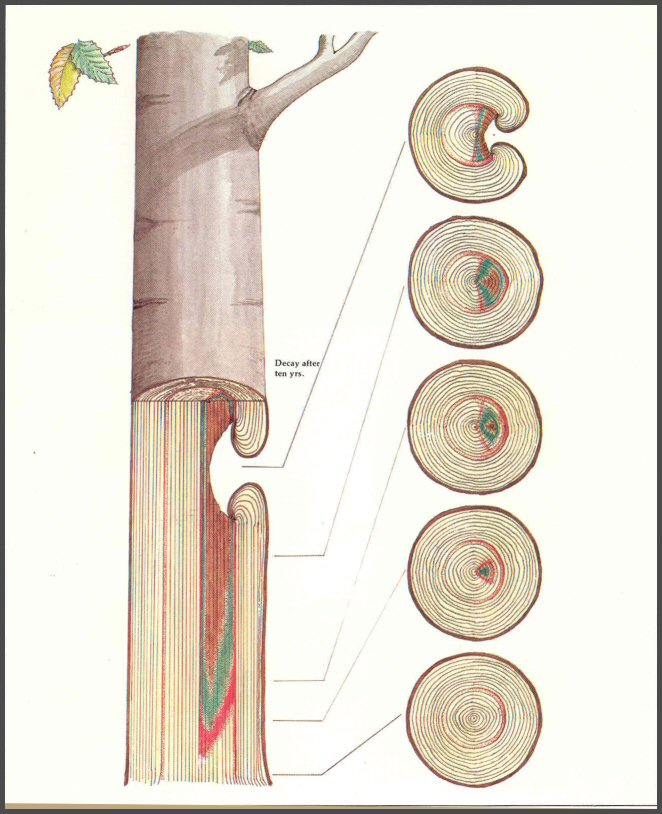
Ten years later-decay developing in BROWN area. Discoloration in GREEN and RED areas. Decay mostly by decay fungi; bacteria and nondecay fungi in GREEN area.
Page 19
The rate of wood decomposition depends on the interactions between the microorganisms and the tree. When the microorganisms are not able to grow through the chemical barriers, the wounds heal. When the microorganisms are able to invade, the tree forms a second line of defense by walling off the invaded tissues. The tree COMPARTMENTALIZES the invaded tissues.
- - - - - - - - - - - - - - - - - - - - - - - - - - - -
Wound healing is the rule in
nature.
- - - - - - -
- - - - - - - - - - - - - - - - - - - - -
Compartmentalization of healed branches.
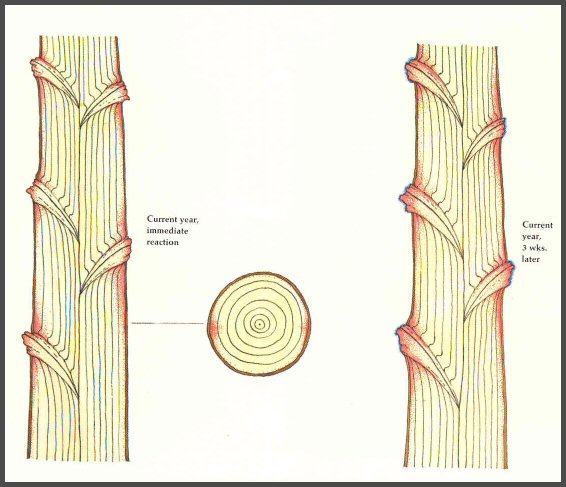
Page 20
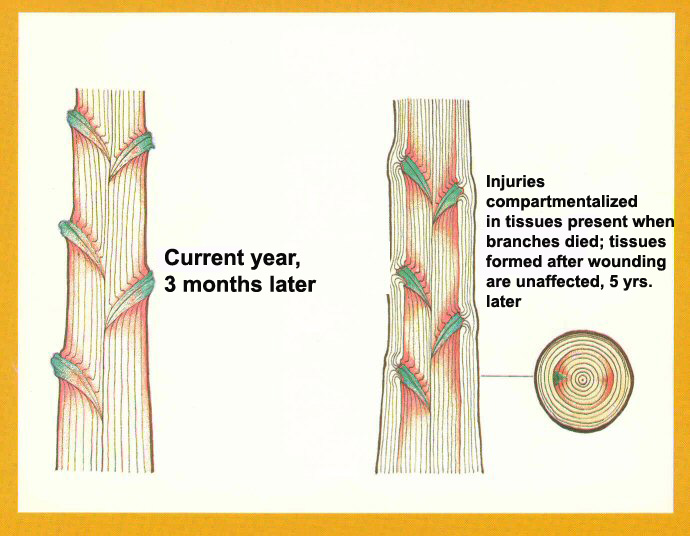
Page 21
Compartmentalization of a healed mechanical wound.
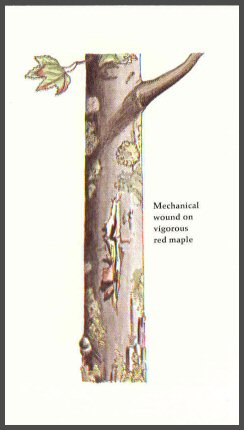
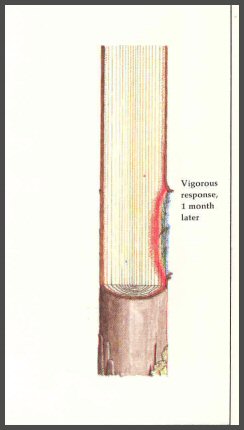
Page 22
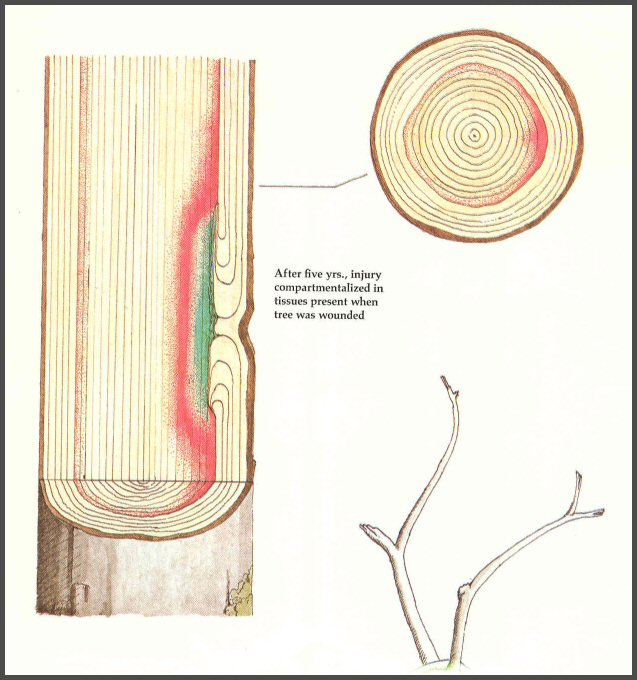
Page 23
Compartmentalization of poorly healed branches.
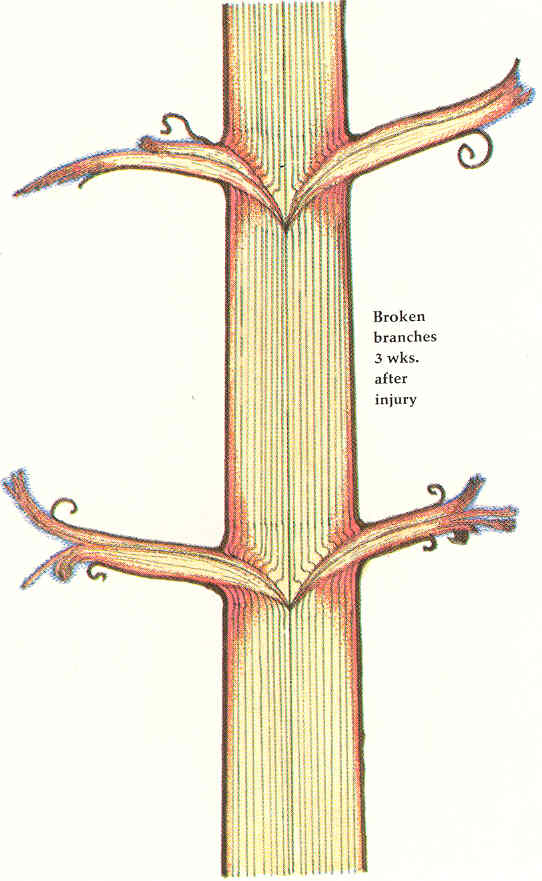
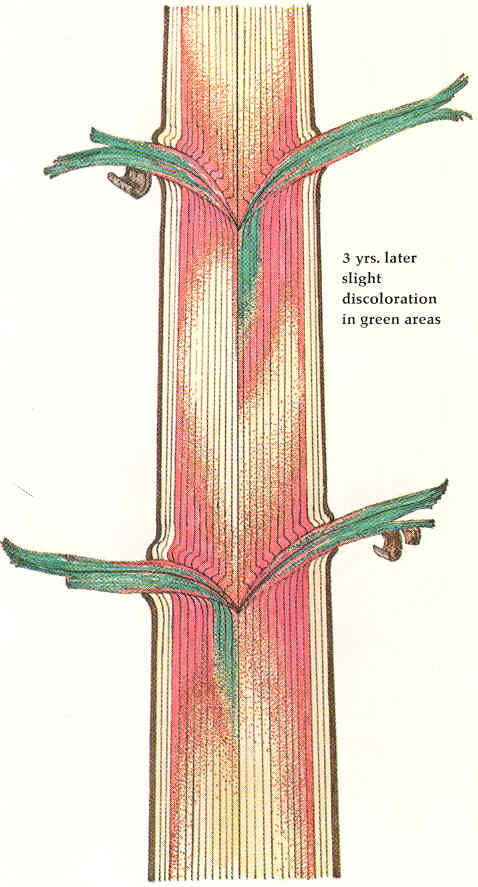
Page 24

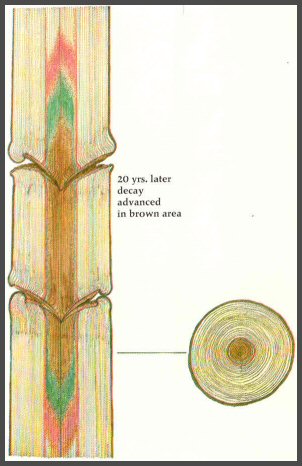
Page 25
Compartmentalization of poorly healed severe mechanical wounds.
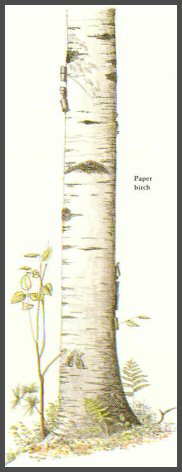


Page 26
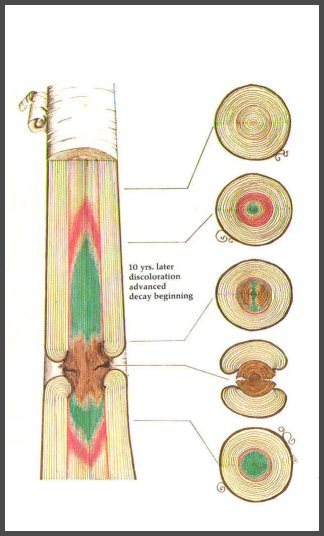

Page 27
What can be done to prevent and minimize damage caused by decay?
HELP THE TREE HELP ITSELF AFTER WOUNDING:
1. Prevent wounds; use care when working around trees.
2. Clean wounds; cut torn bark, and shape wound like an ellipse when possible.
3. Sanitation; remove dead, dying, and weak branches from the injured tree.
4. Water and fertilize properly.
5. Contact professionals for additional advice.
Page 28